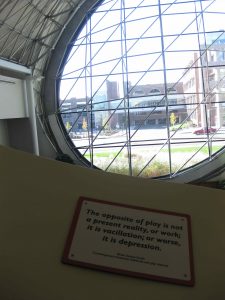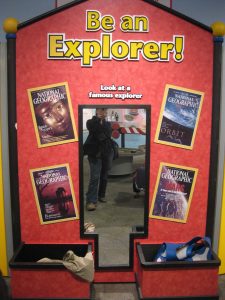This week I’m at the Strong National Museum of Play in Rochester, NY. The Strong Museum possess a complete run of Playthings magazine, which was published from 1903 to 2010 (RIP), and which was read by toy manufacturers, people who owned toy stores, and toy buyers for larger department stories. (During the teens and twenties, they liked to call themselves “toymen”). I’m looking through the magazine in order to find out what the toy industry thought about science toys, and about A.C. Gilbert and Porter Chemcraft in particular, but as happens any time I delve into a historical periodical, I’ve found myself quite distracted by the scenery. Playthings is stuffed full of:
- interesting old toy advertising
- articles about managing your sales force
- corny jokes reprinted from other magazines (ex: “He, nervously: ‘Margaret, there’s been something trembling on my lips for months and months.’ She: ‘Yes, I so I see; why don’t you shave it off?'”)
- pieces about “the Toys of Other Lands” (China, Japan, and the Inuit made frequent appearances)
- articles about the developmental stages of childhood, including up-to-date “modern” psychological information that should be used to “sell” your child customer more effectively (anybody who thinks that the commercialization of childhood is a new phenomenon is sorely misled)
- stories about maximizing your potential as a businessman (their trade secrets for self-realization were mostly “sleep more,” “eat less,” and “never complain about anything”)
- during WWI, rants against German toymakers
- updates on various new types of toys being manufactured.
Here are a few of my favorites from that last category. I can’t post pictures of the ads in the magazine, because of copyright, so these capsule descriptions will have to stand on their own.
Oh! Catchy!: “The sweatshop operator is a catchy little toy. A man is shown bending over a sewing machine. When wound up the man runs the sewing machine at a rapid pace, working away for dear life.” (March 1903)
Very pre-Volstead: “Dolls’ liquor sets are shown in a variety of designs and sizes. They are warranted not to produce intoxication in the most susceptible doll.” (June 1903)
Don Draper Doll: “A Smoking Doll devised by Samuel W. Stern, Brooklyn, New York, has a tube extending from a cigarette in the doll’s mouth to a bulb within the doll, and another tube extending from the bulb with branches leading to the doll’s mouth and nose so that when the bulb is pressed by pressing against the body of the doll, it will cause smoke to issue from the ‘cigarette’ and from the doll’s nose. Patent 1,143,458.” (July 1915)
I’ll Be Watching You: “Newcomers in the bear market include an excellent line of electric eyed bears shown in standing position with ribbon across the chest. They come in white, cinnamon and black and have rings in their noses.” (July 1915) The ads for this product were exceptionally frightening: the bears have Terminator eyes, which they train on their unsuspecting child owners. Then I found this little follow-up, which was even scarier: “During a pre-Christmas fire that was the unfortunate holiday gift to an eastern manufacturer, the firemen were handicapped in their flame fighting by thousands of electric-eyed Teddy Bears whose eyes pierced the gloom of the cold, wintry night and blinked a mute plea to be rescued. One of the firemen said that it was one of the most uncanny and at the same time the most pathetic sight he had ever seen.” (December 1916) “Pathetic”? More like “terrifying.” Creepy though that is, it’s still better than the following idea for replacing those electric eyeballs: “A & F Mahler, manufacturers of artificial eyes for stuffed toys are finding an ever increasing market for radium eyes. These luminous optics are capable of glowing in the dark for a distance of 15 feet and aside from their attractiveness serve a distinctly useful purpose as well. If, for instance, baby awakes during the night she can always locate her playfellow without awakening the entire household. Tired business men should particularly should appreciate the radium eye toy.” (March 1921) That’s one dangerous playfellow.

It's a pretty fair bet that I'll never do research at another archive that is accessed by a Translocation Capsule.
That sounds different now: “Morris Michtom, the ‘Poo Bah’ of the Ideal Novelty and Toy Co, reports an unprecedented demand for his famous line of American dolls…..there is the ‘Baby Bi-Face,’ a doll with a reversible head, one side showing a laughing youngster and the other a kid that is crying like a thunderstorm.” (February 1916)
Question Authority: “D.P. Clark has some startling innovations this year, which have evoked a small storm of well deserved applause. The 1916 line of the Dayton Friction Toy Co. contains a feature newcomer in what is called ‘The Speedway Limited,’ a real automobile race chuck full of mad speed, the thrill of the race and the joy of killing the country constable who vainly tries to stop the fun. Special banked trackage is offered, oval in shape, around which two racing autos whirl at record breaking speed, the autos being wound up to the racing pitch by a few turns of the starting crank…an interesting feature of the race occurs when the operator pushes a lever and causes a country sheriff to stand in the center of the track in an endeavor to stop the speeding autos. Needless to say he is knocked flat and the racers pass over his flattened body again and again.” (February 1916) “Needless to say”?
Of course, there’s plenty of racism: “A very amusing toy is Uncle Sam and the Mexican Bandit. In this novelty Uncle Sam boxes the ears of the Mexican and gives him some vigorous kicks; but the Mexican Bandit doesn’t stay still—he makes a desperate effort to get away, at the same time wielding his Mexican knives.” (September 1916) Lest you think that this couldn’t possibly have been a kid’s toy, but instead must have been a novelty for businessmen to entertain each other with, the same issue had an ad with an illustration of a family at their breakfast table playing with this particular object.
I can’t picture it: Describing a doll tie-in to the Krazy-Kat comics: “This cat is big and black and floppy, but with a wild and weird face that looks like a cross between ‘The Masked Marvel’ and a Swiss cheese with a college education.” (November 1916)
“Intellectual” must have meant something different back then: “Another unique number is the ‘Intellectual Pup’. There is a nice little dog kennel with a fence around it and a bull pup on a chain. On top of the house, however, is a disturbing element in the nature of a cat. The child tries to shoot the cat and if he is successful the pup will jump out of the kennel, throw open the gate and bark.” (January 1917)

At the entrance to the Strong Museum. Future historians may be just as confused by this "heely skating" as I am by the "Intellectual Pup."
Huns-be-Gone: “The United States Steel Toy Co has introduced the ‘Hun Hunter,’ which is a child’s car, finished in battleship gray with the exception of the centers of the wheels which are in bright red. The car is steered by the means of a gun on top of the steering post, and in this way the gun is always pointed at the place to which the child wishes to go. The car sells for 2.50, F.O.B. Boston, and is making a very favorable impression.” (Oct 1918) Toys from the WWI period were particularly explicit in their militarism. You could buy a “machine gun” called “Big Dick,” a “Boy Scout” branded cannon, and a “trench digging kit” that would enable your child to simulate trench warfare at the beach (or, the manufacturer hopefully noted, in the snow—the ability to stimulate year-round sales was of particular concern for toy factories). I think I may write about these World War One toys in the next issue of Paperweight (theme: Ghosts).


